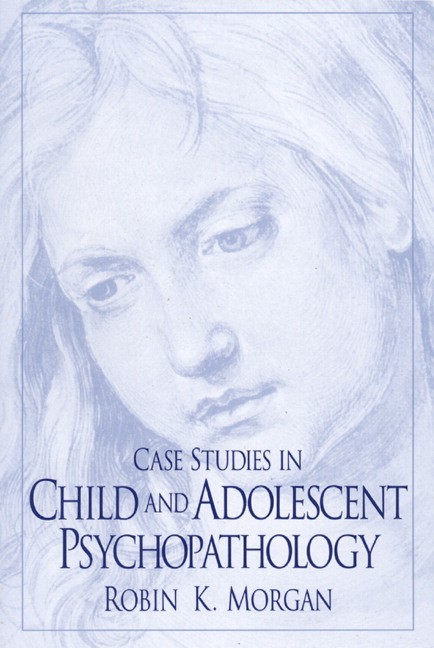Case Studies in Child
and Adolescent Psychopathology

About The Author
Robin K. Morgan received her doctorate in clinical psychology from Auburn University in 1988. She is a Professor of Psychology at Indiana University Southeast where she presently serves as the Director of the Institute of Learning and Teaching Excellence, overseeing face-to-face and distance education. She has served as the Indiana University Director of the Faculty Academy on Excellence in Teaching, a system wide organization devoted to recognizing and advocating for excellence in teaching. As Director, she served as the editor of the Journal of the Scholarship of Teaching and Learning as well as the founder and editor of the Journal of Teaching and Learning with Technology. She has published numerous articles in the scholarship of teaching and learning, student stalking of faculty, and authored or co-authored several books including three in the Quick Hits series of Successful Strategies for Award Winning Teachers. The second edition of her Case Studies in Child and Adolescent Psychopathology was published in 2017. Robin has received numerous teaching awards with her most recent award being the President’s Award for Excellence in Teaching and Learning with Technology at Indiana University.
Description
A supplementary text for upper-level undergraduate/beginning graduate-level courses in Child and Adolescent Psychopathology. Also appropriate for courses in psychiatric social work, nursing, and counseling. Although there are many case study books that focus on adults diagnosed with various psychological disorders, this is the first casebook devoted exclusively to major child and adolescent disorders and their common treatments. Consistent with the standard texts available, it organizes disorders according to the DSM-IV, and allows students to “diagnose” and consider treatment options before seeing how a case was actually diagnosed and treated. It provides detailed descriptions of a range of clinical problems affecting children and adolescents, and illustrates some of the ways these problems can be examined and treated.
Learning Objectives
Case 1: Natasha, 9
Case 2: Joey, 4
Case 3: Jimmy, 7
7.
Describe the symptoms exhibited by a 7-year-old male with attention deficit
hyperactivity disorder.
Case 4: Randall, 12
10.
Describe the symptoms exhibited by a
12-year-old male with oppositional defiant disorder and attention deficit
hyperactivity disorder.
11.
Identify treatment goals.
12.
Formulate a treatment plan.
Case 5: Scott, 10
13.
Describe the symptoms exhibited by a 10-year-old male with conduct disorder,
childhood-onset type, mild
14.
Identify treatment goals.
15.
Formulate a treatment plan.
Case 6: Eric, 8
16.
Describe the symptoms exhibited by an 8-year-old male with encopresis, secondary
type.
Case 7; Sam, 14
19.
Describe the symptoms exhibited by a 14-year-old male with obsessive-compulsive
disorder and transient tic disorder.
20.
Identify treatment goals.
21. Formulate a treatment plan.
Case 8: Amanda, 7
22.
Describe the symptoms exhibited by a 7-year-old female with social phobia.
23.
Identify treatment goals.
24.
Formulate a treatment plan.
Case 9: Ian, 8
25.
Describe the symptoms exhibited by an 8-year-old male with selective
mutism.
Case 9: Ian, 8
25.
Describe the symptoms exhibited by an 8-year-old male with selective
mutism.
27.
Formulate a treatment plan.
Case 10:
28.
Describe the symptoms exhibited by a 15-year-old female with alcohol dependence,
with physical dependence.
29.
Identify treatment goals.
Case 11: Lee, 12
31.
Describe the symptoms exhibited by a 12-year-old male with alcohol intoxication and
marijuana intoxication.
33.
Formulate a treatment plan.
Case 12: Cathy, 14
34.
Describe the symptoms exhibited by a 14-year-old female with paranoid
schizophrenia.
35.
Identify treatment goals.
36.
Formulate a treatment plan.
Case 13: Anne, 14
37.
Describe the symptoms exhibited by a 14-year-old female with major depressive
disorder and rule out: borderline personality disorder.
38.
Identify treatment goals.
39.
Formulate a treatment plan.
40.
Describe the symptoms exhibited by a 7-year-old male with major depressive
disorder.
42.
Formulate a treatment plan.
Case 15:
Carly, 15
43.
Describe the symptoms exhibited by a 15-year-old female with major depressive
disorder.
44. Identify treatment goals.
45.
Formulate a treatment plan.
Case 16: Michael, 8
46.
Describe the symptoms exhibited by an 8-year-old male with gender identity disorder
in children.
48.
Formulate a treatment plan.
Case 15:
Carly, 15
43.
Describe the symptoms exhibited by a 15-year-old female with major depressive
disorder.
44. Identify treatment goals.
45.
Formulate a treatment plan.
Case 16: Michael, 8
46.
Describe the symptoms exhibited by an 8-year-old male with gender identity disorder
in children.
47.
Identify treatment goals.
48.
Formulate a treatment plan.
Case 17:
49.
Describe the symptoms exhibited by a 15-year-old female with bulimia nervosa,
purging type and major depressive disorder.
51.
Formulate a treatment plan.
Case 18: Maria, 12
52.
Describe the symptoms exhibited by a 12-year-old female with psychological factors
affecting medical condition and maladaptive health behaviors affecting heart
functioning.
53.
Identify treatment goals.
54.
Formulate a treatment plan.
Case 19: Lisa, 17
55.
Describe the symptoms exhibited by a 17-year-old female with anorexia nervosa,
restricting type.
56.
Identify treatment goals.
57.
Formulate a treatment plan.
Case 20: Patrick, 10
58.
Describe the symptoms exhibited by a 10-year-old male with sleep terror disorder
and sleepwalking disorder.
59.
Identify treatment goals.
60.
Formulate a treatment plan.
Case 21: Joe,
12 and Erin, 10
61.
Describe the symptoms exhibited by a 12-year-old male and a 10-year-old female with
physical abuse of child diagnoses.
63.
Formulate a treatment plan.
Evaluation of Individual Objectives
To assess the effectiveness of the course material, we ask that you evaluate your achievement of each learning objective on a scale of A to D (A=excellent, B=good, C=fair, D=unsatisfactory). Please indicate your responses next to each learning objective and return it to us with your completed exam."Good, straight forward & useful in my practice." - M.C.A., LCSW, NC